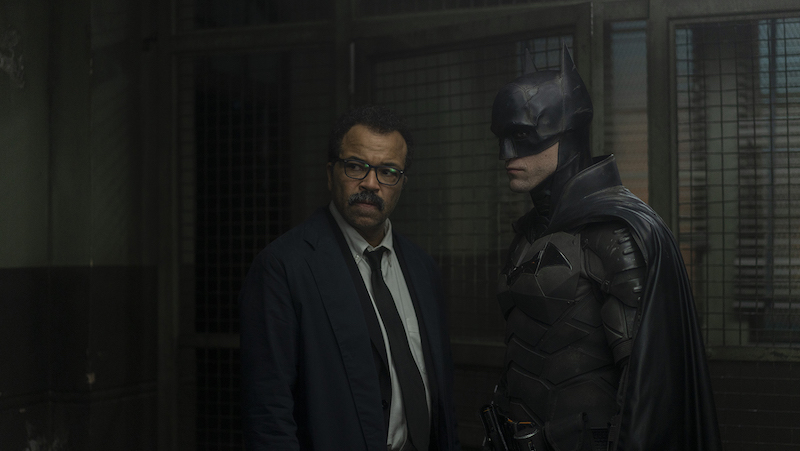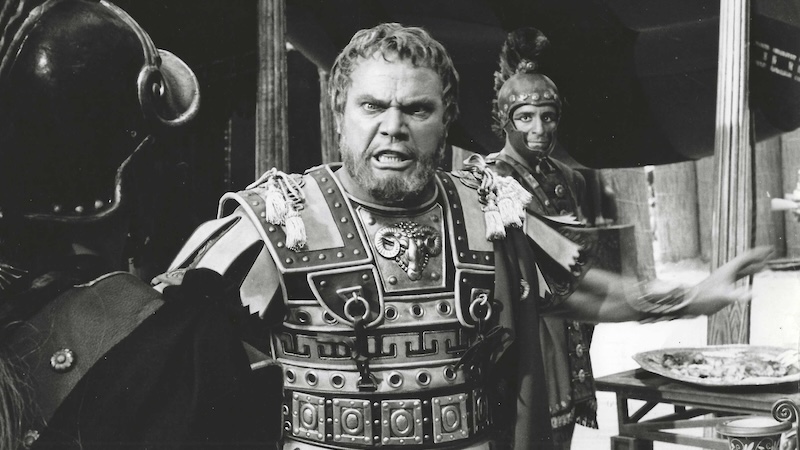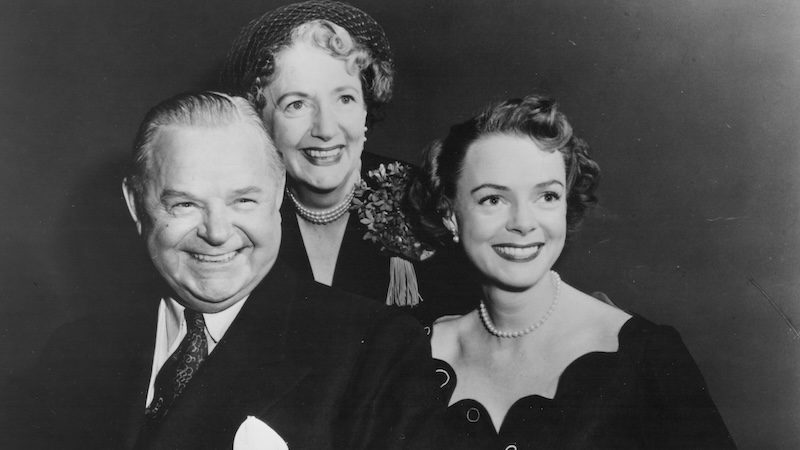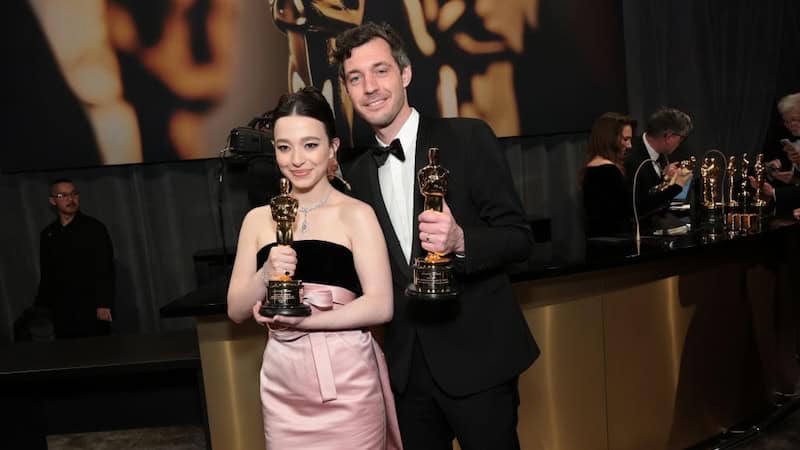‘The Batman’ Review: A Dark Antihero
A tortured Robert Pattinson goes even darker than ‘The Dark Knight’

Where do you go after “The Dark Knight”? Ben Affleck blew it, and even Christopher Nolan, who brought unprecedented levels of realism and gravitas to that franchise-best Batman saga, couldn’t improve on what he’d created in his 2012 sequel. So what is “Cloverfield” director Matt Reeves’ strategy? Answer: Go darker than “The Dark Knight,” deadlier than “No Time to Die” and longer than “Dune” with a serious-minded Batman stand-alone of his own.
Leaning in to those elements doesn’t automatically mean audiences will embrace Reeves’ vision. But this grounded, frequently brutal, and nearly three-hour film noir registers among the best of the genre, even if – or more aptly, because – what makes the film so great is its willingness to dismantle and interrogate the very concept of superheroes.
Sure, that’s been done before – “Who watches the Watchmen?” Alan Moore memorably asked, influencing decades of spandex-clad savior stories – though Reeves does something relatively unique here, at least by comic-book-movie standards: He strips the genre of its supernatural elements (even more than the Nolan trilogy did) and introduces a more complex version of a classic pulp hero who’s only a whisker’s breadth removed from the story’s bad guy, morally speaking. Whereas these movies are typically defined by their villains, “The Batman” gets under your skin by asking: What if the good guys aren’t really the good guys? What if the person we were counting on to protect us might actually be making the situation worse?
While Batman – who’s played here by gloomy “Twilight” star Robert Pattinson, representing the orphaned character’s tortured psychology to an almost painful degree – focuses on punching out petty thugs in shadowed alleys and on subway platforms, the Riddler (a genuinely disturbing Paul Dano) emerges to expose/dispose of the white-collar scoundrels embedded at the highest levels of power. Both men are vigilantes, though one is preoccupied with helping the police, while the other targets the systemic corruption that undermines our faith in such institutions – in Gotham City, for sure, but off screen as well.
In ways far more unsettling than most audiences might expect, “The Batman” channels the fears and frustrations of our current political climate, presenting a meaty, full-course crime saga that blends elements of the classic gangster film with cutting-edge commentary about challenges facing the modern world. It’s a hugely ambitious undertaking and one that’s strong enough to work even without Batman’s presence, not that it would have any reason to exist without him. But by incorporating the character and so many of the franchise’s trademarks – Catwoman (a slinky Zoe Kravitz), the Penguin (Colin Farrell, all but unrecognizable), loyal butler Alfred (Andy Serkis, fully analog) and an epic car chase involving the latest iteration of the Batmobile – Reeves electrifies the dense, ultra-dark proceedings with an added level of excitement that justifies the film’s relatively demanding running time.
From the beginning, the director breaks from the stylistic influences of the genre, establishing a tone that almost never feels derivative of other comic book movies. That said, one could certainly point to Jeph Loeb and Tim Sale’s killer serial “The Long Halloween” as a common thematic influence between this and “The Dark Knight.” That’s where crime boss Carmine Falcone (John Turturro) comes from, though practical action sequences hew closer to Korean films (like “Old Boy”) than Nolan’s nouveau-’70s style.
“NO MORE LIES,” reads the blood-red indictment scrawled across the face of the Riddler’s first victim, no less a figure than Gotham’s unsavory mayor (Rupert Penry-Jones). That’s just one of several grisly murders perpetrated by this maniacal avenger, who’s as twisted and self-righteous as that sicko from the “Saw” movies.
Edward Nashton, aka the Riddler, wears greasy Coke-bottle glasses and what looks like a leather fetish hood (it turns out to be a winter combat mask), livestreaming his mind games on a message board for conspiracy crackpots. But here’s the twist: There really is a conspiracy among Gotham’s most powerful, one that traces back to the Wayne family, and it falls to Bruce to untangle it before it tears the city apart. Why him? The Riddler has drawn Batman in, leaving handmade cards loaded with ciphers and other puzzles at each of his crime scenes.
Part of the film’s “reality” is to avoid calling comic-book characters by their traditional names. You no doubt noticed the “the” in the title of “The Batman” and asked yourself what it’s meant to signify. In using the definite article, Reeves isn’t necessarily trying to say that he’s created “the” definitive screen incarnation of the character. If anything, that tiny extra word casts an air of existential mystery around its masked and anonymous hero, who doesn’t even know what to call himself early on. When the imposing leader of a violent street gang taunts, “The hell are you supposed to be?” the bat-clad vigilante growls back, “I’m Vengeance.”
That’s how Bruce Wayne thinks of himself when we first meet this version of the character – no origin story, but rather, in medias res – two years into defending Gotham from the brink of anarchy. Ravaged by a major narcotics epidemic, courtesy of a street drug called “drops,” the city finds itself facing a level of disorder somewhere between a pre-Giuliani Manhattan and the final minutes of Todd Phillips’ “The Joker,” though the two films exist in different dimensions of the same Gotham multiverse. Reuniting with production designer James Chinlund (with whom he worked on the “Planet of the Apes” sequels), Reeves presents the most robust version of Gotham we’ve seen since Tim Burton’s 1989 “Batman.”
Clearly modeled on New York City, amplified through set extensions and stunning CGI, this seedy metropolis plunges us into the Big Apple’s rotten core: The midtown equivalent of Times Square is illuminated by even more giant digital screens, a black cluster of buildings looms where lower Manhattan would be, and you don’t want to go anywhere near the Madison Square Garden-like arena where the finale takes place. At times, Batman surveys the city from an upper floor of a half-built skyscraper. Otherwise, he zooms around at street level on his Batcycle, eventually upgrading to a souped-up muscle car (the unveiling of which is one of the film’s big thrills).
Except for hidden-camera contact lenses, his technology is mostly realistic, and unless one counts a rooftop BASE jump, he can’t fly. Unlike so many DC comic book heroes, Batman is neither a god nor an alien; he has no fantastical abilities. Bruce Wayne’s superpower is his billion-dollar fortune, but the guy behind the mask breaks and bleeds just like anybody else – a point Reeves reminds us of with a shot of Pattinson’s bare back, covered in scars. Rather than leaning on a theme, Michael Giacchino’s score surprises, ranging from tense tribal drums to Nirvana to opera, while editors William Hoy and Tyler Nelson avoid obvious angles, leaving quiet spaces for audiences to process (and question) what’s happening.
As the Batman or Vengeance or whatever he’s called, Pattinson is the most sullen of the actors to have played the character, which reads as a kind of daredevil nihilism whenever he’s in costume: He doesn’t seem fearless so much as ambivalent about whether he lives or dies. Once the cowl comes off, however, Pattinson’s interpretation gets more intriguing: Brooding and withdrawn, he’s a damaged loner with unresolved daddy issues, saddled with all kinds of complicated emotional trauma. It’s tough to see a hero hurting so much, and yet, his troubled past informs every relationship, including the one with a lunatic who counts Bruce Wayne among his targets.
The Riddler’s schemes are genuinely scary, far more than seems reasonable for a PG-13-rated movie (like the remote-controlled exploding collar clamped on Peter Sarsgaard’s drugged-out district attorney, Gil Colson). The idea here is that some of Gotham’s top-ranking officials – plus cat burglar-cum-cocktail waitress Selina Kyle (Kravitz) – are somehow mixed up with Falcone, and the Riddler has taken it upon himself to purge the system of such elements. The “Chinatown”-intricate specifics of just how intertwined city government is with organized crime can make your head spin, though Reeves lays it out relatively elegantly, such that audiences can follow the many twists of Batman’s investigation.
This is first and foremost a detective story, unsentimental as they come – one half-expects Gwyneth Paltrow’s head to show up in a box at some point – and though the authorities take the Riddler into custody well before the end, the movie’s most shocking stretch is still to come, just when Gotham seems ready to celebrate its next chapter. It’s hard to imagine how Reeves (who was shooting “The Batman” during the early days of the pandemic) could have anticipated the Jan. 6 Capitol riot, and yet, the signs must have been there all along, for the film’s chilling climax hinges on activating susceptible citizens to conduct a mass terrorist attack. In “The Dark Knight,” Heath Ledger’s anarchist Joker felt like he’d stepped right out of your nightmares, but there’s something even more intimidating about the way the Riddler operates. He literally triggers others to become vigilantes as well – and judging by the real-world copycats previous Batman movies inspired (such as the Aurora, Colo., shooting), that could have consequences.
A movie like this will inspire countless debates: Does “The Batman” really need to be this dark? Can it hold a candle to Nolan’s trilogy? There’s room enough for both to exist, and space for sequels to build on this foundation, which assumes a certain familiarity with the character’s mythology. That’s the beauty of Batman, who transcends all the other heroes in the DC Comics stable: Like Dracula or Hamlet, this iconic antihero stands up to endless reinvention. Whether campy or pop, self-questioning or complicit, he tells us something new about ourselves every time he steps out of the shadows.
’The Batman’ official movie site
© 2022 Variety Media, LLC, a subsidiary of Penske Business Media; Distributed by Tribune Content Agency, LLC
CAPTION: Jeffrey Wright (left) as Lt. James Gordon and Robert Pattinson in ’The Batman.’ (Warner Bros. Pictures/TNS)
Digging into Batman’s past:
’No, Batgirl, Get Out Quick!’ – The emasculated TV heroine
Remembering the original Batwoman
Where Are They Now? Lee Meriwether, Batwoman (2014)
Where Are They Now? Burt Ward, Batman turned canine crusader (2016)


